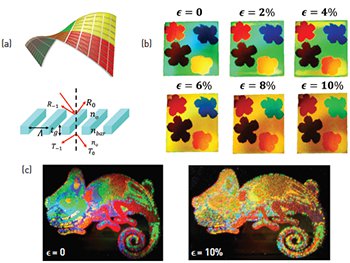 (a) Schematic of color-tunable material and HCMs. (b) Flower pattern under different deformations. (c) Chameleon pattern under relaxed state and stretched state.
(a) Schematic of color-tunable material and HCMs. (b) Flower pattern under different deformations. (c) Chameleon pattern under relaxed state and stretched state.
Synthetic skin that can change color on demand, like a chameleon’s, has been highly desired for camouflage, display, sensing and other applications. One approach to that goal is structural coloration, which uses microscopically structured material to split the color. Efforts have been made to use the accumulative optical interference across multiple layers to provide a desired color, which is changed by varying the thickness of the material.1
However, even if the thickness could be controlled with sufficiently fine resolution, such an approach is not ideal for complex color patterns. Diffractive optics offers a way to define the color lithographically, with color tuning achieved by deforming the elastomeric gratings.2 Due to the low refractive indices of the elastomeric materials, the typical efficiency of the color splitting is less than 10 percent.
This year, our group created a color-tunable material by embedding a silicon metastructure in a flexible substrate to achieve highly efficient color splitting, harnessing up to 83 percent of the incoming light for coloration.3 The brilliant colors created can be tuned from green to orange—crossing a 39-nm wavelength range by a mere 25-nm change in the structure period.
Such a large performance enhancement is accomplished through a unique anomalous diffraction phenomenon in high-contrast metastructures (HCMs). HCMs are periodic structures made of high-refractive-index material and fully surrounded by the low-index medium, with the period very close to the wavelength of interest. In our design, we choose the period to allow only two diffraction orders, 0th and –1st order. By designing the optical interference of the array waveguide modes inside the HCM region at the exiting interface, the optical power can be concentrated in any of the diffraction orders.
We experimentally demonstrated more than fifteen-fold enhancement of the power in the –1st order over the 0th order, which breaks the prediction of conventional diffraction theory for planar gratings. As shown in the figure, for both a flower pattern including five different colors and a chameleon pattern, all colors are efficiently tuned with only 10 percent deformation of the elastomeric substrate.
We envision that this material could enable a new class of display technology, adding brilliant, active colors to any arbitrary surface. Additionally, because the color change is sensitive to the mechanical change, it can be an excellent sensor for structural-fatigue detection in buildings, bridges or airplane wings.
Researchers
Li Zhu, Jonas Kapraun, James Ferrara and Connie Chang-Hasnain, University of California, Berkeley, Calif., USA
References
1. M. Kolle et al. Opt. Express 18, 4356 (2010).
2. M. Aschwanden and A. Stemmer. Opt. Lett. 31, 2610 (2006).
3. L. Zhu et al. Optica 2, 255 (2015).
